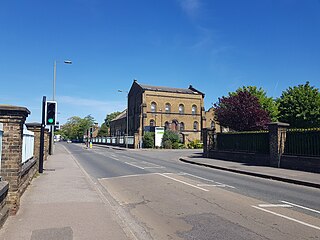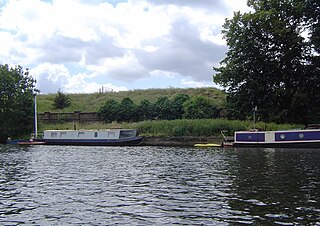
Hampton is a suburban area on the north bank of the River Thames, in the London Borough of Richmond upon Thames, England, in the historic County of Middlesex.

Seething Wells is a neighbourhood in southwest London on the border between Surbiton in the Royal Borough of Kingston upon Thames in Greater London, and Elmbridge in Surrey. The area was historically a waterworks that supplied London with water from the River Thames. Nowadays it is mainly a residential area, with the notable exception of decommissioned filter beds — the Seething Wells Filter Beds — in the northwest part of the area that borders the Thames.

The Metropolitan Water Board was a municipal body formed in 1903 to manage the water supply in London, UK. The members of the board were nominated by the local authorities within its area of supply. In 1904 it took over the water supply functions from the eight private water companies which had previously supplied water to residents of London. The board oversaw a significant expansion of London's water supply infrastructure, building several new reservoirs and water treatment works.

Molesey Lock is a lock on the River Thames in England at East Molesey, Surrey on the right bank.

The Molesey Reservoirs were a group of reservoirs in England near Molesey, Surrey, in the western suburbs of London. There was an adjacent water treatment works.

The Stain Hill Reservoirs in London, England with embankments occupy 0.175 square kilometres. They are a pair which sit high between others; Kempton Nature Reserve; riverside houses in Sunbury-on-Thames; and a low area of flood meadow to the west alongside the closing stretch of the Port Lane Brook. Other nearby settlements are Molesey, Hampton and Hanworth.

The Bessborough Reservoir is an embanked storage reservoir south of the River Thames in Surrey adjacent to the Knight Reservoir. To the south lies Queen Elizabeth II Reservoir and to the north the now disused Molesey Reservoirs. The A3050 runs to the north of the reservoir and the neighbouring town is Molesey to the east. It forms part the green buffer between Molesey and Walton on Thames. The reservoir is in the borough of Elmbridge.

The Knight Reservoir is a large pumped storage reservoir located in the Borough of Elmbridge in Surrey. It was inaugurated in 1907 and stores up to 2,180 million litres of raw water abstracted from the River Thames prior to its treatment and supply to London and north Surrey. It is located south of the River Thames, west of West Molesey, and between Hurst Road (A3050) and Walton Road (B369). It is adjacent to, and west of, its twin Bessborough Reservoir.

London's water supply infrastructure has developed over the centuries in line with the expansion of London.

The Chelsea Waterworks Company was a London waterworks company founded in 1723 which supplied water to many central London locations throughout the 18th and 19th centuries until its functions were taken over by the Metropolitan Water Board in 1904.

The East London Waterworks Company was one of eight private water companies in London absorbed by the Metropolitan Water Board in 1904.
Joseph Quick was an English civil engineer who was closely involved in improvements to supply piped water in the great industrial cities of the nineteenth century. Both his father and his son were also waterworks engineers by the name Joseph Quick.
The Southwark and Vauxhall Waterworks Company was a utility company supplying water to parts of south London in England. The company was formed by the merger of the Southwark and Vauxhall water companies in 1845 and became part of the publicly owned Metropolitan Water Board in 1904.

The Broad Street cholera outbreak was a severe outbreak of cholera that occurred in 1854 near Broad Street in Soho, London, England, and occurred during the 1846–1860 cholera pandemic happening worldwide. This outbreak, which killed 616 people, is best known for the physician John Snow's study of its causes and his hypothesis that germ-contaminated water was the source of cholera, rather than particles in the air. This discovery came to influence public health and the construction of improved sanitation facilities beginning in the mid-19th century. Later, the term "focus of infection" started to be used to describe sites, such as the Broad Street pump, in which conditions are favourable for transmission of an infection. Snow's endeavour to find the cause of the transmission of cholera caused him to unknowingly create a double-blind experiment.
The Grand Junction Waterworks Company was a utility company supplying water to parts of west London in England. The company was formed as an offshoot of the Grand Junction Canal Company in 1811 and became part of the publicly owned Metropolitan Water Board in 1904.
The West Middlesex Waterworks Company was a utility company supplying water to parts of west London in England. The company was established in 1806 with works at Hammersmith and became part of the publicly owned Metropolitan Water Board in 1904.
The history of water filters can be traced to the earliest civilisations with written records. Water filters have been used throughout history to improve the safety and aesthetics of water intended to be used for drinking or bathing. In modern times, they are also widely used in industry and commerce. The history of water filtration is closely linked with the broader history of improvements in public health.

The history of water supply and sanitation is one of a logistical challenge to provide clean water and sanitation systems since the dawn of civilization. Where water resources, infrastructure or sanitation systems were insufficient, diseases spread and people fell sick or died prematurely.
Essex and Suffolk Water is a water supply company in the United Kingdom. It operates in two geographically distinct areas, one serving parts of Norfolk and Suffolk, and the other serving parts of Essex and Greater London. The total population served is 1.8 million. Essex and Suffolk is a 'water only' supplier, with sewerage services provided by Anglian Water and Thames Water within its areas of supply. It is part of the Northumbrian Water Group.

The Metropolis Water Act 1852 was an Act of the Parliament of the United Kingdom which introduced regulation of water supply companies in London, including minimum standards of water quality for the first time.













